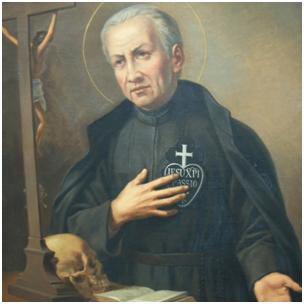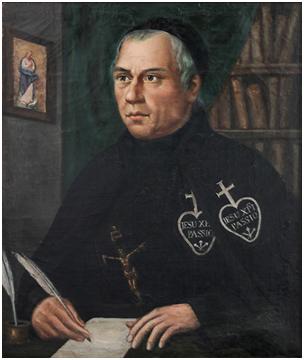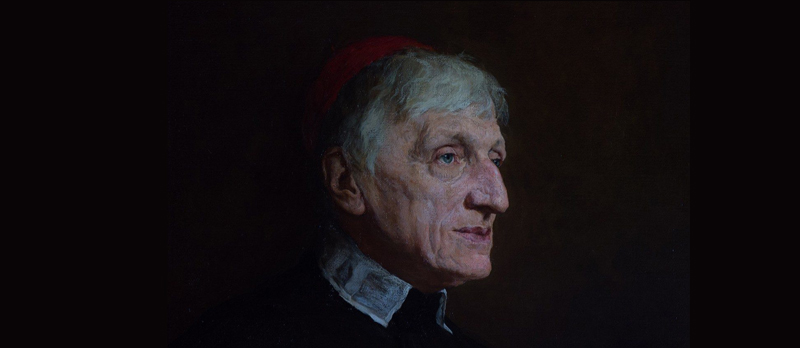“…Moreover, obtain the victory of Our Holy Mother Church over her enemies, the conversion of sinners, the return to the Catholic faith of heretics and especially England, for which you prayed so much …”, from the traditional novena to Saint Paul of the Cross for his feast day, April 28th, according to the old calendar, in Filotea ossia l’annosantificato (book of prayers and meditation, viz. the year sanctified, pg 313, Rome, 1923)
Strangely enough, as was the case with his beatification on September 19th, 2010, also on the occasion of his canonization on October 13th, 2019, as far as one could see, the fascinating background history leading to the conversion of St. John Henry Newman (1801-1890) was almost ignored by the overwhelming majority of the main mainstream secular and non-secular printed and electronic media. Yet, as one can reasonably argue, his conversion did not come out of the blue, but can be regarded the end result of a century old process dating at least as far back as 1694, the year when Saint Paul of the Cross (1694-1775), founder of the Passionists, was born in Ovada, a town in the province of Alessandria in Piedmont. But what does Saint Paul of the Cross have to do with Saint John Henry Newnan? Very briefly, everything.
In 1845 John Henry Newman was received into the Catholic Church by a Passionist father, Blessed Domenico Barberi (1792-1849), also known as Domenico della Madre di Dio (Dominic of the Mother of God), who was precisely a spiritual son of Saint Paul, who had mandated him to establish a Passionist mission in England. Incidentally, whether by coincidence or design, Blessed Newman canonisation has taken place in October 2019, which was proclaimed Extraordinary Missionary Month to celebrate the 100th anniversary of Pope Benedict XV’s Apostolic Letter Maximum Illud (That Momentous) in order to foster greater awareness of “missio ad gentes” (mission to all peoples).
Again, but why a mission in England? What most people may be not aware of is that for mysterious reasons, England’s return to the Catholic fold became one of Saint Paul’s main apostolic concerns, up to the point that he made this a specific purpose of his apostolate. As recounted in his biography by Passionist father Luigi-Teresa di Gesù Agonizzante (S. Paolo della Croce, Rome, 1952), during his first trip to Rome in 1721 he prayed in front of the miraculous image of Our Lady Salus populiromani in the basilica of Saint Mary Major, vowing to propagate the devotion to the passion of Our Lord around the world (pg 69). The central position of England in this mission, as revealed in the biography (pgs 248-249), he himself was not able to explain in human terms, as if a mysterious force was pushing him in this direction. Since it was not his will to do so, therefore it was certainly mandated by God. He prayed for the conversion of England for over fifty years, first and foremost in every morning mass. One day, during one of these masses, he was reported as having had a half an hour vision of England in the future, while another day at the end of his mass he exclaimed: “Oh. what did I see this morning! My sons, the Passionists, in England!”, bursting into tears of consolation. As a matter of fact, the saint’s dream for the establishment of a Passionist mission started to come true when the Passionist father Blessed Domenico Barberi landed in England in 1841.

Thus, if Pope Francis was able to canonize John Henry Newman we must be grateful to Saint Paul because if he was indirectly responsible for his conversion, it was Blessed Domenico Barberi who was directly responsible for it. In fact, as reported in his biography by the Passionist father Federico dell’Addolorata (Il Beato Domenico della Madre di Dio, Isola del Liri, 1963), he played a major role in Newman’s conversion (pg 398) and it was him who formally received the then leading Anglican priest and intellectual into the Catholic Church on October 9th, 1845 (pgs 383-385).
"The significance of Dominic Barberi to John Henry Newman cannot be overestimated”, the English Provincial Fr John Kearns was quoted as saying in Independent Catholic News online (October 15th, 2019). “Even before reaching England Bl Dominic maintained a significant, supportive correspondence with the Oxford Movement and in this way became known to, and appreciated by, the new Saint”. Newman is on record for having said that “he still needed to see something from the Catholic Church which he could not find within his own tradition, that is, someone who would go poor and barefoot amongst the most neglected members of society. In Dominic this he saw, and so it was not by accident that John Henry asked the Passionist to receive him into the Roman Catholic Church. Newman said that there was something special about Dominic, so much so that even looking at him made him aware of the presence of God" (cit.).

As quoted by Fr Alexander Lucie-Smith in Catholic Herald (28 August, 2017), this is what Newman himself had to say about the Italian Passionist:
Father Dominic was a marvelous missioner and a preacher filled with zeal. He had a great part in my own conversion and in that of others. His very look had about it something holy. When his form came within sight, I was moved to the depths in the strangest way. The gaiety and affability of his manner in the midst of all his sanctity was in itself a holy sermon. No wonder that I became his convert and his penitent. He had a great love for England.
Albeit known for his kindness and his sense of humor, Fr. Lucie Smith goes on:
It was zeal that was his chief characteristic, which drew souls to God. He actually believed with all his heart what he wanted other people to come to believe as well, and his converts knew it. That was why there were so many of them.
As a matter of fact, Blessed Barberi had to pay a high price for the fruits of his apostolate during his years in England, where he established three churches and several chapels, preached innumerable missions and received hundreds of converts. At the heart of his action were very simple secrets: tireless prayer and harsh penance. After all this is the basic recipe for a successful apostolate, there are no shortcuts. Suffice thinking of Saint Jean-Baptiste-Marie Vianney (1786 - 1859), commonly known in English as Saint John Vianney and often referred to as the "Curéd'Ars" (the parish priest of Ars), who started his mission in Ars with his local parish church totally empty, a bitter consequence of the religious crisis triggered by the French revolution. But by his incessant prayer and penance, slowly but surely the church began to fill up, with the end result of increasingly interminable hours spent at the confessional for penitents coming from around France and beyond.
In much the same way, the penance and ensuing sufferance endured by Blessed Barberi were at the base of his success, in terms of increased numbers of faithful and converts in his initial community in Aston and Stone. This penance was manifold, including the frequent verbal and physical hostility of ordinary people, protestant ministers and even local Catholics, whose main fear was that these “intruders” might have sparked a new spate of persecutions. To the youths who threw stones and mud to him while he was walking along in his Passionist habit, he reacted by kissing each stone that hit him and putting it in his pocket. Two of them were so edified that subsequently decided to become Catholic. And here, incidentally, one cannot but think at the similar episode during the “Breccia di Porta Pia”, viz. the capture of Rome on September 20th, 1870, when the Piedmontese-led Italian army ended the existence of the Papal States under the Holy See after over a millennium: one of the officers leading the charge on the eternal city subsequently repented and became a priest.
But the sufferings of Blessed Barberi prior to Newman’s conversion is just one of the sides of the medal, the second being the sufferings endured by Newman himself after his conversion. “One of the most important aspects of his life is the long and difficult journey he made into the fullness of faith in the Catholic Church”, the Bishop of Westminster and head of the English bishops’ conference, Cardinal Vincent Nichols, was quoted as saying in a September 29 pastoral letter (Cf. Catholic News Agency, September 30, 2019). It cost him dearly. Yet it is an essential part of his witness”.
His words were echoed on October 14, 2019, on the occasion of a Mass of Thanksgiving for Newman’s canonization, celebrated at the Basilica of St John Lateran in Rome by the British Bishop of Hexham and Newcastle, Msgr. Robert Byrne. In fact, as reported in Catholic Herald (October 15th, 2019):
Newman’s 1845 conversion to the Catholic faith was controversial in England, and resulted in the loss of many friends, including his own sister, who never spoke to him again.
But to make up for it, “he did much to promote the Christian cause in bringing the Congregation of the Oratory to England, founding a University in Ireland and a school in Edgbaston” Msgr. Byrne was quoted as saying during the mass (cit.). “He worked tirelessly as a Parish Priest and had a fatherly care for his Oratorian community. He guided countless people with letters of spiritual direction and counsel. He gave light to those who were searching for the truth and continues to do so through his published works of theology, philosophy, sermons and prayers”.
In other words, the import and impact of his legacy was “immense”, as His Royal Highness himself, the Prince of Wales, acknowledged in his article in honour of the newly-proclaimed saint in Osservatore Romano of October 12th, 2019. As immense is probably the number of those, especially English-speaking people, who embraced the Catholic faith thanks to this lasting legacy, so much so that many of them were reported to have been in attendance of his canonization (see “ ‘Newman converts’ come home to Rome for canonization”, Catholic News Agency, October 13th, 2019).
In an interview in ZENIT (23 September 2010) Joseph Pearce, a British scholar and a Catholic convert who has published numerous books on the great Christian intellectuals, including Newman, was quoted as saying that:
The number of converts who owe their conversion, under grace, to Newman, at least in part, are too numerous to mention. As such, a few will suffice to illustrate the point.
Among others, he mentioned “Gerard Manley Hopkins, arguably the finest poet of the Victorian era, (who) was received into the Church by Newman in 1866”; Oscar “Wilde's ultimate deathbed conversion … (that) was due in part to the beguiling presence of Newman's enduring influence”; “Hilaire Belloc and J.R.R. Tolkien (who) both studied at the Birmingham Oratory School, which had been established by Newman … Newman's role in their Christian formation contributed to the faithful fortitude that animated their lives as Catholic writers of the utmost importance”; others like “Graham Greene, Evelyn Waugh and Muriel Spark could be mentioned among the many others, documented in my book ‘Literary Converts? (Ignatius Press), who owed their conversion, at least in part, to Newman's benign influence”. Lastly, “I must mention that Newman's beautiful and profound ‘Apologia pro Vita Sua’ played a significant role in my own path to conversion”.
The above interview took place at the time of Benedict XVI visit to the UK, where he beatified Newman in Birmingham on September 19th, 2010. This visit, almost forgotten by now, turned into an exceptional success that stunned both supporters and detractors. “During the four days of engagements, millions of people in England and Scotland truly opened their hearts to the Pope and his message of faith and reason amid the quagmire of a decaying culture”, noted Pearce in his interview (cit.). “Newman is rightly considered to be the father of the Catholic revival and the seismic power of his conversion continues to reverberate throughout the English-speaking world”
It’s no exaggeration to claim that Blessed Father Barberi with his Passionist confreres, and before them Saint Paul of the Cross himself--who as already stated prayed for the conversion of England for fifty years leaving this commitment as a spiritual legacy to his congregation--must also be credited for the above overwhelming success. In fact, Blessed Father Barberi did not limit to accept all the trials inevitably associated to his apostolate, but “he made a vow to renounce all material and spiritual consolation and offered himself to the Lord for the conversion of England” (cf. Independent Catholic News online, cit.), thus literally consuming his life for this purpose on the English soil. No surprise then if his grave in Sutton, St Helens, has become a place of pilgrimage. This is also the shrine of the Passionist Servants of God, Fr Ignatius Spencer (another of Barberi's converts and ancestor of Princess Diana) and Mother Elizabeth Prout, the founder of the feminine Passionist branch in England. Interestingly, her spiritual trajectory was a bit similar to Newman’s: in her early twenties she converted to Catholicism under the influence of Father Barberi, as well as another Passionist, Father Gaudentius Rossi, but her conversion was initially met with great hostility by her parents, both of whom however subsequently converted to Catholicism.
Alberto Carosa
(This article originally appeared in the Remnant on Sunday, November 17, 2019)
Back to the news


 OTHER
OTHER